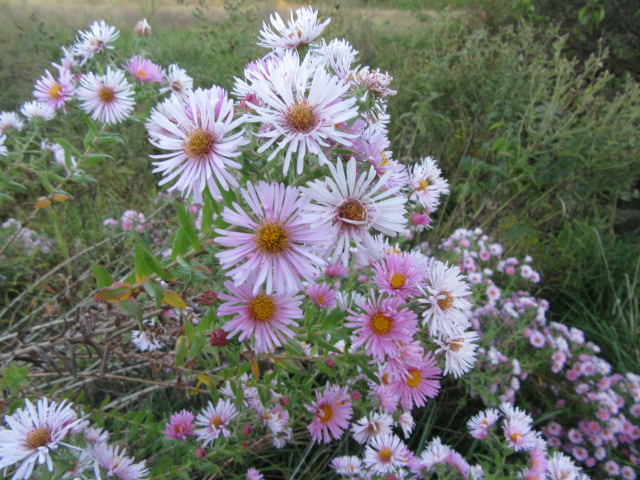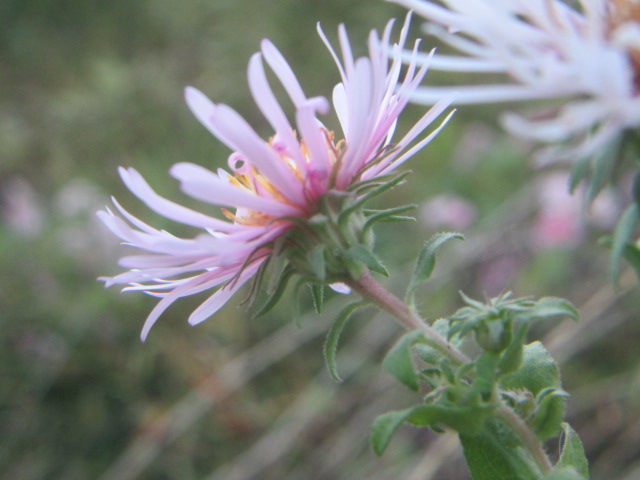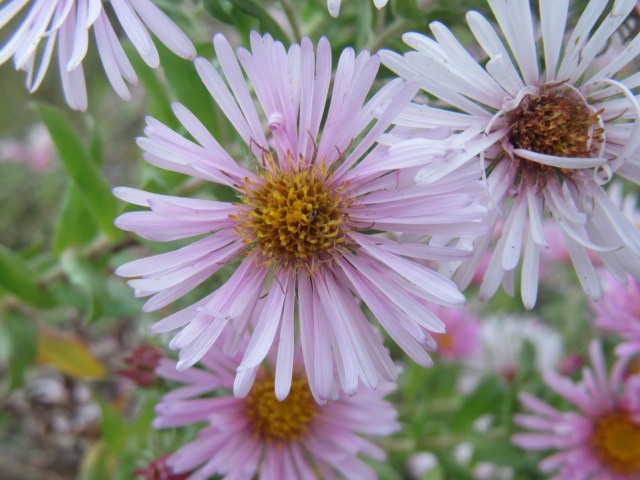
Symphyotrichum novae-angliae (New England Aster) on 9-28-21, #836-24.
New England Aster
Symphyotrichum novae-angliae
sim-fy-oh-TRY-kum NO-vee ANG-lee-a
Synonyms of Symphyotrichum novae-angliae (18) (Updated on 12-4-23 from Plants of the World Online): Aster altissimus Moench, Aster amplexicaulis Lam., Aster muehlenbergii Tausch, Aster novae-angliae L., Aster novae-angliae f. geneseensis House, Aster novae-angliae var. monocephalus Farw., Aster novae-angliae f. rosarius House, Aster novae-angliae f. roseus Britton, Aster novae-angliae var. roseus A.Gray, Aster novae-angliae f. spurius (Willd.) Voss, Aster repertus Mottet, Aster roseus Desf., Aster spurius Willd., Aster spurius var. novae-angliae (L.) W.P.C.Barton, Diplactis novanglia Raf., Lasallea novae-angliae (L.) Semple & Brouillet, Symphyotrichum novae-angliae f. roseum (Desf.) G.Wilh. & Rericha,Virgulus novae-angliae (L.) Reveal & Keener
Symphyotrichum novae-angliae (L.) G.L.Nesom is the accepted scientific name for the New England Aster. It was named and described as such by Guy L. Nesom in Phytologia in 1995. It was previously named Aster novae-angliae by Carl von Linnaeus in the second volume of the first edition of Species Plantarum in 1753.
The genus, Symphyotrichum Nees, was named and described as such by Christian Gottfried Daniel Nees von Esenbeck in Genera et Species Asterearum in 1832.
As of 12-4-23 when this page was last updated, Plants of the World Online by Kew lists 100 species in the Symphyotrichum genus. It is a member of the plant family Asteraceae with 1,702 genera. Those numbers could change as updates are made on POWO. The number of genera in this family fluctuates quite often.

Distribution map of Symphyotrichum novae-angliae from Plants of the World Online. Facilitated by the Royal Botanic Gardens, Kew. Published on the Internet; http://www.plantsoftheworldonline.org/. Retrieved on October 3, 2021.
The above distribution map for Symphyotrichum novae-angliae is from Plants of the World Online. Areas in green are where the species is native and purple is where it has been introduced. The map on the USDA Plants Database is similar but also includes California and British Columbia.
The map on iNaturalist shows where members have made observations. Anyone can join and it is a great website to confirm and share your observations. The maps on iNaturalist are continually updated as members post new observations. I add all my observations to iNaturalist.
THERE ARE SEVERAL LINKS AT THE BOTTOM OF THE PAGE FOR FURTHER READING AND TO HELP WITH A BETTER POSITIVE ID.

Symphyotrichum novae-angliae (New England Aster) on 10-3-21, #839-1.
I have been back on the family farm since 2013 and I am always finding new wildflowers to identify. I didn’t actually start identifying wildflowers that much until 2019. On September 28 in 2021, I was headed to take wildflower photos when I spotted a mass of pink behind the pond in the front pasture. I walked to the area and found a species I hadn’t noticed before. To me, that sounds weird since I had been back here since 2013… I took a few photos of the flowers so I could upload them on iNaturalist to get an idea then headed to where I was originally going. The photo at the top of the page was the one I saved and uploaded to iNaturalist. That evening, I uploaded the photo and the top suggestion was Symphyotrichum novae-angliae, commonly known as New England Aster. I cross-referenced their suggestion on the Missouri Plants website and it was correct. My first thought was, “WOW! I actually positively identified a Symphyotrichum!” Until then, I was avoiding trying to identify members of the genus on the farm because some look so much alike. Since then, I have identified six species of Symphyotrichum right here on this 40 acre farm…
Symphyotrichum novae-angliae is perennial wildflower native to North America that has been introduced other countries as well. This species is fairly easy to tell from others in the genus by the size and color of its flowers, number of ray florets (petals), plant height, and habitat.
Plants can be found in part to full sun in moist to average soil conditions. Here, they grow in loamy soil, but they grow in soils with more clay as well. They can be found in bottomland prairies, fens, along pond margins and streambanks, in pastures, along fencerows, ditches, etc.
I went back and took more photos on October 3… There are more photos through 2023 at the bottom of the page under the links for further reading. The dates on this main page won’t be in order and they primarily go with the descriptions.

Symphyotrichum novae-angliae (New England Aster) on 10-3-21, #839-2.
One to several stems grow from a stout caudex. The root system is fibrous and produces short thick and longer, thin creeping rhizomes.
I went back on 10-3 to take photos of the base of the plant and get an official measurement. The above photo shows where multiple stems have come up from the base which you can’t see very well because of the grass.

Symphyotrichum novae-angliae (New England Aster) at 78″ tall on 10-3-21, #839-3.
Getting a measurement was a little tricky. I did it first by standing the stem up and measuring it from the base. It was 78″ tall… I couldn’t take a photo with it standing up, so I had to let it lay down so I could get a photo. Some websites say they only grow to around 40 or so inches tall. I suppose it all depends on their geographic location and growing conditions.

Symphyotrichum novae-angliae (New England Aster) on 9-30-21, #837-10.
The stems are erect to ascending, branching out above the center, and have short spreading hairs. These hairs are usually absent toward the base of the stems. The stems usually flop over from the weight of the upper stems and clusters of flowers. Plants can grow from 4’ to over 6’ tall.

Symphyotrichum novae-angliae (New England Aster) on 9-30-21, #837-11.
Symphyotrichum novae-angliae produces A LOT of leaves compared to others in the genus on the farm. The leaves grow in an alternate pattern along the stems and are up to 4” long x 1” wide, growing smaller as they ascend the stems. Leaves are narrowly oblanceolate, broader in the center, narrowing to a sharply pointed tip. The bases are fairly broad and tightly clasp the stems with somewhat rounded lobes. The margins of the leaves are smooth (no teeth) and hairy. The upper surface of the leaves have very short, fine hairs while the undersurface also has longer hairs along the veins. The basal and lower leaves fall off before. flowering.

Symphyotrichum novae-angliae (New England Aster) on 9-2-22, #908-30.
In the above photo taken on September 2 in 2022, you can see what the plants looked like before the flowers appeared. The stems are more upright and the middle and lower leaves have already dried…

Symphyotrichum novae-angliae (New England Aster) on 10-1-22, #913-15.
The flowering stems terminate in clusters of flower heads on fairly long peduncles (flower stems).

Symphyotrichum novae-angliae (New England Aster), 1 1/2″ diameter, on 9-30-21, #837-7.
Individual flowers are around 1 1/2” wide and consist of 40-100 or more ray florets (petals) in 2-3 series that are normally in various shades of purple or pink, and around 50-110 yellow disc florets. The disc florets are 5 lobed and eventually turn a purplish color. The ray and disc florets are fertile, and possibly the disc florets are bi-sexual…

Symphyotrichum novae-angliae (New England Aster) on 10-1-22, #913-17.
Flowers are subtended by an involucre with narrow bracts in 4-5 series.

Symphyotrichum novae-angliae (New England Aster) on 12-12-21, #859-23.
Fertile flowers are replaced by numerous seeds (achenes) that are carried away by the wind by their hairs. The involucral bracts persist even after the seeds are dispersed.

Symphyotrichum novae-angliae (New England Aster) on 12-12-21, #859-24.
The above photo shows what the “achenes” with their hair look like.
The flowers attract several types of bees, butterflies, skippers, and flies that collect pollen and nectar. Some aid in pollination. Various insects and caterpillars of several moths feed on the leaves.
I took 3 more photos of this species in 2023 (at the bottom of the page) but still didn’t get close-ups of the flowers, leaves, and stems. We had the worst drought in 2023 that I can remember. Hopefully 2024 will be better.
I have enjoyed photographing and learning about the many wildflowers growing on the farm I live on and in other areas. The farm is located in Windsor, Missouri in Pettis County (Henry County is across the street, and Benton and Johnson aren’t far away). I have grown over 500 different plants and identified over 250 species of wildflowers (most have pages listed on the right side of the page). I am not an expert, botanist, or horticulturalist. I just like growing, photographing, and writing about my experience. I rely on several websites for ID and a few horticulturalists I contact if I cannot figure them out. Wildflowers can be somewhat variable from location to location, so sometimes it gets a bit confusing. If you see I have made an error, please let me know so I can correct what I have written.
I hope you found this page useful and be sure to check the links below for more information. They were written by experts and provide much more information. Some sites may not be up-to-date but they are always a work in progress. If you can, I would appreciate it if you would click on the “Like” below and leave a comment. It helps us bloggers stay motivated. You can also send an email to me at thebelmontrooster@yahoo.com. I would enjoy hearing from you especially if you notice something is a bit whacky.
There are many other great websites with information about this species. There are also sources of seeds and plants. Several popular cultivars are mentioned on the Gardenia website (see link below).
FOR FURTHER READING:
PLANTS OF THE WORLD ONLINE (GENUS/SPECIES)
INTERNATIONAL PLANT NAMES INDEX (GENUS/SPECIES)
TROPICOS (GENUS/SPECIES)
FLORA OF MISSOURI (GENUS/SPECIES)
FLORA OF NORTH AMERICA (GENUS/SPECIES)
WORLD FLORA ONLINE (GENUS/SPECIES)
WIKIPEDIA (GENUS/SPECIES)
USDA PLANTS DATABASE
USDA PLANT GUIDE
DAVE’S GARDEN
MISSOURI PLANTS
MISSOURI BOTANICAL GARDEN
MISSOURI DEPARTMENT OF CONSERVATION
UNIVERSITY OF MISSOURI-WEED ID GUIDE
iNATURALIST
WILDFLOWER SEARCH
ILLINOIS WILDFLOWERS
MINNESOTA WILDFLOWERS
KANSAS WILDFLOWERS AND GRASSES
NORTH CAROLINA STATE UNIVERSITY
PFAF (PLANTS FOR A FUTURE)
GO BOTANY
FLORA FINDER
FRIENDS OF THE WILDFLOWER GARDEN
LADY BIRD JOHNSON WILDFLOWER CENTER
MARYLAND BIODIVERSITY PROJECT
U.S. FOREST SERVICE
SANTA FE BOTANICAL GARDEN
UNIVERSITY OF WASHINGTON-BURKE HERBARIUM
MICHIGAN FLORA
GARDENIA
U.S. WILDFLOWERS
NOTE: The data (figures, maps, accepted names, etc.) may not match on these websites. It depends on when and how they make updates and when their sources make updates. Some websites have hundreds and even many thousands of species to keep up with. Accepted scientific names change periodically and can be hard to keep with. Some of the links may use a name that is a synonym on other sites. In my opinion, Plants of the World Online by Kew is one of the most reliable and up-to-date plant databases and they make updates regularly. I make updates “at least” once a year and when I write new pages or add new photos but I do get behind. We are all a work in progress. 🙂
More photos from 2021, 2022, and…

Symphyotrichum novae-angliae (New England Aster) on 9-30-21, #837-8.

Symphyotrichum novae-angliae (New England Aster) on 9-30-21, #837-9.

Symphyotrichum novae-angliae (New England Aster) on 8-8-22, #903-26.

Symphyotrichum novae-angliae (New England Aster) on 8-8-22, #903-27.

Symphyotrichum novae-angliae (New England Aster) on 9-2-22, #908-31.

Symphyotrichum novae-angliae (New England Aster) on 10-1-22, #913-14.

Symphyotrichum novae-angliae (New England Aster) on 10-1-22, #913-16.

Symphyotrichum novae-angliae (New England Aster) on 9-24-23, #963-42.

Symphyotrichum novae-angliae (New England Aster) on 9-24-23, #963-43.

Symphyotrichum novae-angliae (New England Aster) on 9-24-23, #963-44.